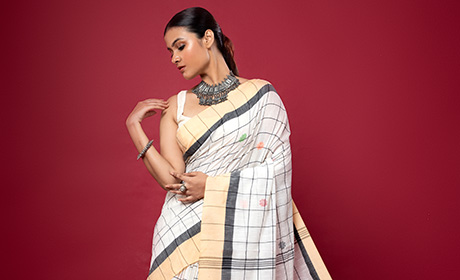Saree is the most common among all the traditional attire in the Indian Subcontinent, as well as it embodies centuries of tradition, cultural diversity, and evolution. Its journey from ancient times to modern-day fashion reflects changes in societal norms, fashion trends, and craftsmanship. The history of the saree can be traced back over five thousands years, with depictions found in ancient sculptures, paintings, and texts across the Indian subcontinent. Initially, the saree was a simple cloth draped around the body, worn by women of all social strata. Fabrics like cotton, silk, and later, muslin, were used, showcasing the rich textile heritage of the region. The early sarees were unstitched, allowing for versatile draping styles that varied by region.
However, with the advent of the Islamic rule in the Indian subcontinent, saree and the style of wearing it started getting highly influenced by the various Persian and Central Asian cultures. Very fine detailed and intricate embroideries were found in saree during the Mughal Era, sometimes various gold and silver threads also became popular. Benarasi, Zardosi, and various types of saree started getting popular among the women from higher classes.
After the Mughal era, the Europeans came to India, and with them they brought newer fashion trends and dresses. The people of India, under the European influence started adopting the Western dresses more, but saree remained resilient with the flow of time, though it adopted new preferences and style. The introduction of synthetic dyes and mechanized weaving processes further diversified the saree’s material and design options.
Post-independence, there was a resurgence in interest in traditional crafts and handloom sarees. Designers began integrating traditional motifs with modern aesthetics, catering to a global audience. The saree became a symbol of cultural identity and a statement of fashion on international runways.
Nowadays, the saree continues to evolve as a symbol of grace and elegance, worn not only in South Asia but also globally by people of South Asian diaspora. Its versatility allows it to be draped in various styles, suitable for formal events, weddings, and everyday wear. Designers experiment with fabrics, prints, and embellishments, ensuring its relevance in contemporary fashion. And all these played a key role in the revival of saree as a fashion trend, and many foreigners are loving to wear it when they visit India. The popularity of saree exceeds the borders and started getting adapted by many foreigners across the globe. Even women who are working in various corporate offices wear the formal dresses in their office, but on some special occasions, they prefer traditional attire in their office, such as Durga Puja, Diwali, Navrati etc., and saree is their top preferences on these days of festivals.
Despite its enduring appeal, the saree industry faces challenges such as competition from mass-produced garments and dwindling artisanal skills. Efforts to promote handloom sarees and sustainable fashion practices are crucial to preserving this cultural heritage.
The evolution of saree over centuries reflects the dynamism of South Asian culture and its ability to adapt to changing times. From humble beginnings to a global fashion icon, the saree remains a timeless symbol of tradition and elegance. Its journey underscores the resilience of indigenous crafts and the enduring allure of handmade textiles in the present fast-paced world.
Threads of Tradition: The Timeless Evolution of the Saree

08
Aug

